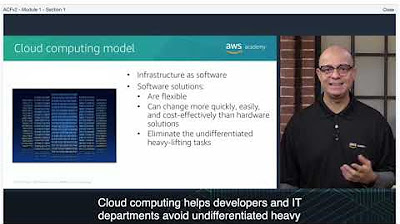Cloud Computing For Beginners | What is Cloud Computing | Cloud Computing Explained | Simplilearn
Summary
TLDRThis tutorial provides a comprehensive introduction to cloud computing, covering its need, benefits, and various models (public, private, hybrid) and services (IaaS, PaaS, SaaS). Samuel, a cloud architect, explains how cloud computing offers scalable, cost-efficient, and secure solutions compared to on-premises infrastructure. The session focuses on AWS, showcasing a hands-on demo with EC2 and S3 services, illustrating how cloud storage and compute resources can work together. By the end, viewers will understand cloud fundamentals and how to deploy a basic cloud-based application on AWS.
Takeaways
- 😀 Cloud computing provides scalable, flexible, and cost-efficient resources over the internet.
- 😀 AWS offers a range of services, including EC2 (virtual machines) and S3 (storage), which are commonly used in cloud-based solutions.
- 😀 Cloud computing helps eliminate upfront costs, reducing the need for on-premise infrastructure.
- 😀 AWS EC2 allows you to create virtual servers in the cloud with flexible configurations and resources.
- 😀 Amazon S3 is a scalable storage service that can be used to store and retrieve data, acting as a central repository.
- 😀 To use AWS services, you first need an AWS account, followed by creating an S3 bucket for storage.
- 😀 After creating an S3 bucket, you can upload files like website content, which can then be pulled by an EC2 instance.
- 😀 EC2 instances can be configured with Apache servers to host content, such as web pages, pulled from S3.
- 😀 The `aws s3 sync` command allows you to synchronize files between S3 and EC2, ensuring data consistency.
- 😀 The AWS ecosystem helps streamline tasks like data synchronization and scaling resources efficiently without needing manual intervention.
- 😀 The tutorial demonstrated practical use of EC2 and S3 to deploy a website, illustrating the real-world benefits of cloud services for developers and businesses.
Q & A
What is the main benefit of cloud computing over on-premises infrastructure?
-The main benefit of cloud computing over on-premises infrastructure is the pay-as-you-go billing model. Cloud services allow businesses to use only the resources they need and scale as required, avoiding high upfront costs and the need for dedicated hardware management.
What does 'cloud computing' mean?
-Cloud computing is the ability to deliver on-demand computing services over the internet, typically on a pay-as-you-go basis. It allows users to store data online and access it from anywhere with an internet connection.
What are the three primary types of cloud deployment models?
-The three primary types of cloud deployment models are Public Cloud, Private Cloud, and Hybrid Cloud. A Public Cloud is shared by multiple users, a Private Cloud is exclusive to one organization, and a Hybrid Cloud integrates both public and private cloud services.
What is the difference between 'Infrastructure as a Service (IaaS)' and 'Platform as a Service (PaaS)'?
-IaaS provides basic computing infrastructure such as virtual machines and storage, allowing users to install and manage their software. PaaS, on the other hand, provides a platform or environment for developers to build and deploy applications without managing underlying infrastructure.
What is the function of Amazon EC2 in the cloud?
-Amazon EC2 (Elastic Compute Cloud) provides resizable compute capacity in the cloud, enabling users to launch and manage virtual machines, known as instances, to run applications.
How does AWS S3 function in cloud storage?
-AWS S3 (Simple Storage Service) is a scalable object storage service that allows users to store and retrieve any amount of data from anywhere. It is often used to store static content like web pages, images, and backups.
Why is it beneficial to use both EC2 and S3 together?
-Using EC2 and S3 together is beneficial because EC2 can act as a virtual server to process data, while S3 serves as storage for that data. EC2 can pull files from S3 to be used in applications, allowing for scalable and efficient cloud computing.
What does the 'pay-as-you-go' model mean in the context of cloud computing?
-'Pay-as-you-go' means that users only pay for the computing resources they actually use, such as storage or processing power. This model allows businesses to scale up or down based on their needs and avoid paying for unused resources.
What are the advantages of using cloud computing over traditional data centers?
-Cloud computing offers several advantages over traditional data centers, including lower upfront costs, less need for physical space, automated updates, easier scalability, and higher security standards provided by cloud vendors.
How does synchronization between S3 and EC2 work?
-Synchronization between S3 and EC2 is done using the AWS CLI command 'aws s3 sync'. This command downloads files stored in an S3 bucket to an EC2 instance, allowing the EC2 instance to use the files for web hosting or application purposes.
Outlines

This section is available to paid users only. Please upgrade to access this part.
Upgrade NowMindmap

This section is available to paid users only. Please upgrade to access this part.
Upgrade NowKeywords

This section is available to paid users only. Please upgrade to access this part.
Upgrade NowHighlights

This section is available to paid users only. Please upgrade to access this part.
Upgrade NowTranscripts

This section is available to paid users only. Please upgrade to access this part.
Upgrade Now5.0 / 5 (0 votes)





